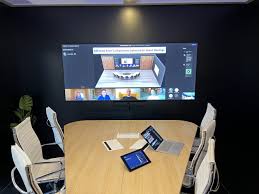MDM Trade Show 2021: Unveiling Innovation and Industry Trends
The MDM Trade Show 2021 is just around the corner, and industry professionals from around the world are eagerly preparing for this highly anticipated event. As one of the leading trade shows in the field of manufacturing, distribution, and supply chain management, MDM promises to showcase the latest innovations, trends, and solutions that are shaping the industry.
This year’s trade show will bring together manufacturers, distributors, suppliers, and technology providers under one roof. It will serve as a platform for networking, knowledge sharing, and exploring new business opportunities. With an impressive lineup of exhibitors and a comprehensive agenda of seminars and workshops, attendees can expect nothing short of an immersive experience.
One of the key highlights of MDM Trade Show 2021 is its focus on innovation. As industries continue to evolve rapidly in response to technological advancements and changing market dynamics, staying ahead of the curve is crucial. The trade show will feature cutting-edge technologies such as artificial intelligence (AI), Internet of Things (IoT), robotics, automation, and advanced analytics. Attendees will have the opportunity to witness firsthand how these innovations are revolutionizing manufacturing processes, optimizing supply chains, enhancing customer experiences, and driving overall business growth.
Moreover, MDM Trade Show 2021 will shed light on emerging trends that are reshaping the industry landscape. From sustainability initiatives to digital transformation strategies, attendees can gain valuable insights into how companies are adapting to meet evolving consumer demands while reducing their environmental footprint. The trade show will also provide a platform for thought leaders to discuss topics like supply chain resilience in times of crisis and navigating global disruptions.
In addition to showcasing innovative solutions and discussing industry trends, MDM Trade Show 2021 offers ample networking opportunities. Attendees can connect with peers from various sectors within manufacturing and distribution industries – fostering collaborations that can lead to mutually beneficial partnerships or even spark new business ventures. The trade show’s networking events, including cocktail receptions and interactive sessions, provide a relaxed environment for professionals to exchange ideas and build lasting relationships.
For those seeking to expand their knowledge and expertise, MDM Trade Show 2021 offers a diverse range of educational sessions. Industry experts will conduct seminars, workshops, and panel discussions on topics such as supply chain optimization, inventory management, e-commerce strategies, and workforce development. These sessions aim to equip attendees with practical insights and actionable strategies that they can implement in their own organizations.
MDM Trade Show 2021 is an event that promises to be both informative and inspiring. From exploring the latest innovations to gaining insights into industry trends and fostering valuable connections, attendees will undoubtedly leave with a renewed sense of purpose and direction. Whether you’re a manufacturer looking for ways to streamline your operations or a distributor seeking new partnerships, this trade show is an opportunity not to be missed.
So mark your calendars for the MDM Trade Show 2021 – where innovation meets industry expertise. Get ready to immerse yourself in the future of manufacturing, distribution, and supply chain management.
6 Advantages of Attending the MDM Trade Show 2021: Embrace the Latest Technology, Network, Learn, Gain Recognition, Explore Innovation, and Affordable Admission!
- Access to the Latest Technology
- Networking Opportunities
- Educational Sessions
- Industry Recognition Awards
- Innovative Exhibitors
- Affordable Admission Price
Challenges of MDM Trade Show 2021: Limited Accessibility, Costly Expenses, Time Commitment, Overwhelming Crowds, and Lack of Variety
- Limited Accessibility
- Costly
- Time Commitment
- Overwhelming Crowds
- Lack of Variety
Access to the Latest Technology
Access to the Latest Technology: Unveiling Innovations at MDM Trade Show 2021
The MDM Trade Show 2021 offers attendees a unique opportunity to witness and experience the latest advancements in technology within the manufacturing, distribution, and supply chain management industries. This highly anticipated event brings together exhibitors showcasing cutting-edge hardware, software solutions, and innovative products and services that are shaping the future of these sectors.
In today’s rapidly evolving business landscape, staying up-to-date with the latest technology is paramount for success. The MDM Trade Show 2021 serves as a hub for industry professionals to explore and interact with state-of-the-art technologies that have the potential to transform their operations. From robotics and automation systems to advanced analytics platforms and Internet of Things (IoT) devices, attendees can witness firsthand how these innovations are revolutionizing manufacturing processes, optimizing supply chains, and driving efficiency.
The trade show provides a hands-on experience where attendees can interact with the showcased technologies. They can ask questions, observe live demonstrations, and gain insights from experts who specialize in implementing these cutting-edge solutions. This direct engagement allows attendees to understand how adopting such technologies can enhance their own business practices and improve overall performance.
Moreover, the MDM Trade Show 2021 enables attendees to compare different technologies side by side. With a wide array of exhibitors offering diverse solutions, visitors can explore various options tailored to their specific needs. Whether it’s finding an efficient inventory management system or discovering new ways to streamline production processes, this trade show provides an invaluable platform for discovering innovative solutions.
The access to the latest technology at MDM Trade Show 2021 extends beyond just hardware and software offerings. Attendees can also explore emerging trends such as sustainability initiatives and digital transformation strategies that are reshaping the industry landscape. By understanding these trends and incorporating them into their own operations, businesses can stay ahead of the curve and meet evolving consumer demands.
Attending the MDM Trade Show 2021 provides a unique opportunity to network with technology providers and industry experts. Engaging in conversations and building connections with these professionals can open doors to potential partnerships, collaborations, and valuable insights. The trade show’s vibrant atmosphere fosters an environment conducive to knowledge sharing and relationship building.
In conclusion, the MDM Trade Show 2021 offers attendees unparalleled access to the latest technology shaping the manufacturing, distribution, and supply chain management industries. From exploring cutting-edge hardware and software solutions to gaining insights into emerging trends, this event equips attendees with the knowledge and resources needed to drive innovation within their own organizations. By embracing these advancements, businesses can enhance their competitiveness, streamline operations, and stay ahead in today’s dynamic business landscape.
Networking Opportunities
Networking Opportunities: Unlocking Business Connections at MDM Trade Show 2021
One of the standout advantages of attending MDM Trade Show 2021 is the ample networking opportunities it offers. This highly anticipated event brings together a diverse range of industry professionals, including potential business partners, suppliers, customers, and thought leaders. These networking interactions provide attendees with invaluable insights into current market trends while fostering connections that can propel their businesses forward.
At MDM Trade Show 2021, attendees have the chance to engage in meaningful conversations with like-minded individuals who share a passion for manufacturing, distribution, and supply chain management. Whether you are a manufacturer seeking new suppliers or a distributor looking to expand your customer base, this trade show serves as a hub for connecting with the right people.
Meeting face-to-face with potential business partners allows for more personalized and in-depth discussions. It provides an opportunity to showcase your products or services directly to interested parties and receive immediate feedback. By engaging in these conversations, attendees can gain valuable insight into market demands, industry best practices, and emerging trends.
The networking events organized during MDM Trade Show 2021 further enhance these connections. From cocktail receptions to interactive sessions, these gatherings create a conducive environment for building professional relationships in a relaxed setting. Attendees can exchange ideas, share experiences, and explore potential collaborations that may lead to exciting business opportunities.
Moreover, networking at MDM Trade Show 2021 goes beyond immediate business partnerships. It also offers access to industry experts and thought leaders who can provide valuable guidance and mentorship. Engaging in conversations with these experienced professionals can offer fresh perspectives on challenges faced by businesses today and help identify innovative solutions.
In addition to expanding professional networks, attending MDM Trade Show 2021 enables attendees to stay up-to-date with current market trends. Through discussions with peers and industry experts, participants gain firsthand knowledge about emerging technologies, changing consumer preferences, and evolving industry regulations. This insight can be instrumental in shaping business strategies and staying ahead of the competition.
Networking opportunities at MDM Trade Show 2021 are not limited to the duration of the event itself. Connections made during the trade show often extend beyond its boundaries, leading to long-term collaborations and partnerships. By nurturing these relationships, attendees can establish a strong support system within the industry, opening doors to new business ventures and growth opportunities.
In conclusion, MDM Trade Show 2021 offers a wealth of networking opportunities that are essential for any business seeking growth and success in the manufacturing, distribution, and supply chain management sectors. By engaging with potential partners, suppliers, customers, and industry professionals, attendees gain valuable insights into current market trends while forging connections that can drive their businesses forward. So seize this chance to unlock new possibilities at MDM Trade Show 2021 – where networking meets innovation!
Educational Sessions
The MDM Trade Show 2021 is offering a unique opportunity for industry professionals to expand their knowledge and stay up-to-date on the latest trends. Through a series of educational sessions, expert speakers will provide seminars on a variety of topics related to the industry. Attendees can learn about marketing strategies, customer service techniques, artificial intelligence applications in retail management systems, and more.
The sessions will be led by experienced professionals who have years of experience in the field and can provide valuable insight into the industry. They will provide attendees with the knowledge and skills they need to stay ahead of the competition and grow their business. Additionally, attendees can network with other professionals in the industry and gain valuable contacts.
Attendees at the trade show will also have access to a variety of exhibitors who are showcasing their products and services. This is an excellent opportunity for attendees to discover new products and services that can help them succeed in their business. There will also be plenty of opportunities for networking with other businesses in the industry, as well as learning about new technologies that could prove beneficial for their operations.
The MDM Trade Show 2021 offers an invaluable opportunity for industry professionals to stay up-to-date on trends and learn from experts in the field. With its educational sessions, exhibitors, and networking opportunities, it is sure to be an event that provides great value for all attendees.
Industry Recognition Awards
Industry Recognition Awards: Celebrating Excellence at MDM Trade Show 2021
One of the standout features of MDM Trade Show 2021 is the Industry Recognition Awards, which honor companies that have made significant contributions towards advancing the industry. These prestigious awards celebrate excellence and recognize the tireless efforts of organizations that have pushed boundaries, embraced innovation, and achieved remarkable success.
At this year’s trade show, attendees will have the opportunity to witness firsthand as these exceptional companies are acknowledged for their outstanding achievements. The Industry Recognition Awards aim to shine a spotlight on those who have demonstrated exemplary leadership, vision, and dedication in driving positive change within the manufacturing, distribution, and supply chain management sectors.
The awards cover various categories that encompass different aspects of industry advancement. From sustainability initiatives to technological innovations, from supply chain optimization to workforce development, each category highlights a specific area where these companies have excelled and made a lasting impact.
By recognizing these trailblazers at MDM Trade Show 2021, the organizers aim to inspire others within the industry to strive for excellence and push boundaries. The award winners serve as role models for aspiring professionals and businesses seeking inspiration on how to make a meaningful difference in their respective fields.
Moreover, the Industry Recognition Awards provide an excellent platform for networking and knowledge sharing. Attendees can connect with representatives from award-winning companies, learn from their experiences, and gain insights into their strategies for success. This exchange of ideas fosters collaboration and encourages industry professionals to work together towards common goals.
The Industry Recognition Awards not only celebrate achievements but also encourage healthy competition among companies. By showcasing best practices and innovative approaches employed by award winners, other organizations are encouraged to raise their own standards and strive for excellence in their operations.
MDM Trade Show 2021 recognizes that collaboration and recognition are vital components in driving industry advancement. By honoring companies that have made significant contributions towards advancing manufacturing, distribution, and supply chain management sectors, the trade show not only acknowledges their achievements but also inspires others to follow suit.
So, join us at MDM Trade Show 2021 and witness the celebration of excellence through the Industry Recognition Awards. Be inspired by the remarkable accomplishments of these companies and discover new possibilities for your own organization. Together, let’s celebrate those who have propelled the industry forward and embrace the spirit of innovation and progress.
Innovative Exhibitors
Innovative Exhibitors: Experience the Latest Offerings at MDM Trade Show 2021
MDM Trade Show 2021 is set to be a hub of innovation, with an impressive lineup of exhibitors from around the world. This year’s trade show promises to showcase the newest products and services available on the market today, providing attendees with a unique opportunity to explore cutting-edge solutions.
The diverse range of exhibitors at MDM Trade Show 2021 ensures that attendees will have access to a wide array of industries and sectors. From manufacturing and distribution to technology and logistics, exhibitors will represent various fields, offering insights into the latest advancements in their respective domains.
This gathering of innovative exhibitors creates an environment where attendees can engage directly with industry experts and experience firsthand demonstrations of groundbreaking products and services. Whether you’re interested in exploring new machinery, software solutions, supply chain optimization tools, or sustainable practices, MDM Trade Show 2021 has something for everyone.
By attending this trade show, you’ll gain valuable insights into emerging trends and technologies shaping the industry. Exhibitors will present their newest offerings, allowing you to stay ahead of the competition by discovering innovative solutions that can enhance your business operations.
Moreover, interacting with exhibitors provides a unique opportunity for networking and building connections within your industry. Engaging in conversations with representatives from different companies can lead to valuable partnerships or collaborations that may drive future growth for your organization.
The presence of international exhibitors further enriches the experience at MDM Trade Show 2021. It offers a global perspective on industry trends and allows attendees to learn from companies operating in different markets. This cross-cultural exchange fosters knowledge sharing and encourages innovative thinking on a global scale.
Attending MDM Trade Show 2021 means being part of a dynamic community that is passionate about driving progress in manufacturing, distribution, and supply chain management. The presence of innovative exhibitors ensures that this trade show will be an invaluable source of inspiration and information for attendees seeking to stay at the forefront of their industries.
So mark your calendars and get ready to explore the latest offerings from around the world at MDM Trade Show 2021. Don’t miss this opportunity to connect with innovative exhibitors, gain valuable insights, and discover cutting-edge solutions that can propel your business forward.
Affordable Admission Price
Affordable Admission Price: Unlocking Opportunities at MDM Trade Show 2021
One of the standout advantages of attending the MDM Trade Show 2021 is its affordable admission price. Compared to other trade shows of its kind, the cost of admission is very reasonable, making it accessible to a wider range of professionals who may have financial constraints or time restrictions.
Trade shows are renowned for being valuable platforms for networking, learning about industry trends, and exploring innovative solutions. However, the high costs associated with attending such events can often pose a barrier for many individuals and smaller businesses. This is where MDM Trade Show 2021 sets itself apart by offering an admission price that accommodates various budgets.
By keeping the admission price affordable, MDM Trade Show 2021 opens doors to professionals who may not have had the opportunity to attend otherwise. This inclusivity ensures that individuals from diverse backgrounds and organizations, regardless of their financial circumstances, can benefit from the wealth of knowledge and opportunities available at the event.
The accessibility provided by the reasonable admission price enables professionals to expand their networks, connect with industry experts, and explore potential collaborations. It allows attendees to tap into a vast pool of resources, gaining insights into cutting-edge technologies, emerging trends, and best practices in manufacturing, distribution, and supply chain management.
Moreover, MDM Trade Show 2021 recognizes that time constraints can also limit professionals’ ability to attend trade shows. With its affordable admission price, more individuals can justify taking time away from their busy schedules to invest in their professional development and stay up-to-date with industry advancements.
Attending MDM Trade Show 2021 offers an exceptional return on investment for participants. By paying an accessible admission fee, attendees gain access to a multitude of exhibitors showcasing innovative products and services. They can attend informative seminars and workshops led by industry experts who share valuable insights and practical strategies.
Furthermore, the affordability factor fosters a diverse and vibrant environment at the trade show. It brings together professionals from various backgrounds, experiences, and perspectives, enriching the overall learning and networking experience for everyone involved.
In conclusion, the affordable admission price of MDM Trade Show 2021 is a significant advantage that sets it apart from other trade shows. By making attendance accessible to a wider audience, this trade show enables professionals with financial constraints or time restrictions to unlock valuable opportunities for growth, learning, and networking. So mark your calendars and take advantage of this affordable gateway to industry excellence at MDM Trade Show 2021!
Limited Accessibility
Limited Accessibility: A Challenge of MDM Trade Show 2021
While the MDM Trade Show 2021 promises to be an exciting event for industry professionals, it’s important to acknowledge one potential drawback: limited accessibility. The trade show’s physical nature means that only those who can physically attend the event may face challenges in participating, particularly for individuals located in remote areas or with limited mobility.
For professionals residing in distant locations, attending the MDM Trade Show may require significant travel arrangements, including flights, accommodations, and time away from work. These factors can pose financial burdens and logistical difficulties, making it challenging for some individuals to justify their attendance.
Moreover, individuals with limited mobility may also find it difficult to fully participate in the trade show experience. Large exhibition halls and crowded spaces can present obstacles for those with mobility impairments, hindering their ability to navigate freely and engage with exhibitors and attendees.
Fortunately, recognizing these limitations is the first step toward addressing them. Event organizers can explore various solutions to enhance accessibility and inclusivity for a wider audience. One option is to incorporate virtual components into the trade show, such as live streaming of key sessions or providing virtual booths for exhibitors. This would allow remote participants to access valuable content and engage with exhibitors without physical presence.
Additionally, offering alternative formats like webinars or online workshops could enable individuals who are unable to attend in person to still benefit from the knowledge-sharing aspect of the trade show. By embracing digital platforms and technologies, organizers have an opportunity to expand their reach beyond physical boundaries.
Furthermore, ensuring that the venue itself is accessible is crucial. Implementing measures such as wheelchair ramps, designated resting areas, and accessible restroom facilities can greatly enhance the experience for attendees with disabilities.
By addressing these accessibility challenges head-on, MDM Trade Show 2021 has the potential to become more inclusive and diverse. Embracing technology-driven solutions and creating an environment that accommodates individuals with varying needs will not only expand the reach of the trade show but also foster a more inclusive and enriching experience for all participants.
In conclusion, while the MDM Trade Show 2021 offers numerous benefits and opportunities for industry professionals, it’s important to acknowledge the limited accessibility it presents. By proactively addressing these challenges through virtual components, alternative formats, and improved physical accessibility, event organizers can ensure that the trade show becomes a platform that truly caters to a wider audience, irrespective of geographical location or mobility limitations.
Costly
Costly: The Expense of Attending MDM Trade Show 2021
While the MDM Trade Show 2021 promises to be an exciting and informative event, one cannot overlook the fact that attending it can come with a hefty price tag. From travel expenses to registration fees and other associated costs, the financial commitment required to participate in this trade show can be a significant consideration for many professionals.
One of the major expenses associated with attending the MDM Trade Show 2021 is travel. Depending on your location and distance from the event venue, airfare or transportation costs can quickly add up. Accommodation expenses also need to be factored in, as attendees often need to stay at hotels near the trade show venue. These costs can be particularly burdensome for individuals or smaller companies operating on tight budgets.
In addition to travel expenses, registration fees for trade shows like MDM can be quite substantial. While these fees are typically intended to cover the cost of organizing and hosting the event, they can sometimes act as a deterrent for professionals who may find it difficult to justify such an investment. For startups or smaller businesses in particular, these fees may pose a challenge when considering participation.
Furthermore, there are other associated expenses that should not be overlooked. These include meals, transportation within the city, promotional materials or booth setup costs for exhibitors, and any additional networking events or workshops that require separate payments. All these factors contribute to making attending MDM Trade Show 2021 a costly endeavor.
However, it’s important to note that despite the financial implications, attending trade shows like MDM can offer significant benefits and opportunities. The chance to network with industry professionals from around the world, gain insights into emerging trends and innovations, and forge valuable partnerships cannot be underestimated. It is essential for individuals and businesses considering attendance to carefully weigh the potential return on investment against their budget constraints.
To mitigate some of these costs, planning ahead is crucial. Early bird registration discounts, group rates, and exploring alternative accommodation options can help reduce expenses. Additionally, leveraging technology can provide opportunities to participate in virtual or online components of the trade show, which may offer a more cost-effective alternative.
Ultimately, the decision to attend the MDM Trade Show 2021, despite its associated expenses, will depend on individual circumstances and priorities. It is essential for professionals to carefully evaluate their budget and assess the potential benefits before committing to such an investment.
While attending MDM Trade Show 2021 may come at a significant cost, it is important to weigh the potential advantages against the financial implications. With careful planning and consideration, professionals can make informed decisions about their participation and maximize the value they derive from this renowned industry event.
Time Commitment
Time Commitment: A Consideration for MDM Trade Show 2021
As the highly anticipated MDM Trade Show 2021 approaches, it’s important to acknowledge that attending the event may require a significant time commitment. The trade show spans a full day, necessitating ample preparation and dedicated attendance. While the event offers valuable opportunities for networking, learning, and exploring industry trends, it’s essential to consider the feasibility of this time commitment for individuals and businesses.
For many professionals, time is a precious resource. Balancing work responsibilities, personal commitments, and other professional engagements can be challenging. Attending a full-day trade show like MDM may pose logistical difficulties for some individuals who struggle to allocate an entire day away from their regular routines.
Similarly, businesses must evaluate whether they can afford the time investment required for participation in MDM Trade Show 2021. Allocating resources to prepare for the event, including booth setup, promotional material creation, and staff coordination, demands careful planning and execution. Small or understaffed businesses may find it particularly challenging to spare a full day without negatively impacting their daily operations.
However, despite these considerations surrounding time commitment, it’s crucial not to overlook the potential benefits that MDM Trade Show 2021 offers. The trade show provides an exceptional platform for industry professionals to connect with peers, explore innovative solutions, gain insights into emerging trends, and foster valuable partnerships.
To navigate this con effectively, individuals and businesses can employ strategic planning techniques. Prioritizing attendance at key sessions or events within the trade show agenda can help maximize the value gained while minimizing time spent away from other commitments. Additionally, leveraging technology such as virtual or hybrid attendance options can provide flexibility for those unable to dedicate an entire day physically but still wish to participate in some capacity.
Ultimately, each individual or business must assess their unique circumstances when deciding whether or not to commit their time to MDM Trade Show 2021. While the time commitment may pose challenges, it’s important to weigh the potential benefits against these considerations. By carefully evaluating priorities and exploring alternative participation options, attendees can make informed decisions that align with their goals and constraints.
MDM Trade Show 2021 undoubtedly offers a wealth of opportunities for growth, knowledge sharing, and networking. By considering the time commitment involved and planning accordingly, attendees can make the most of their experience while striking a balance with other obligations.
Overwhelming Crowds
Overwhelming Crowds: A Challenge at MDM Trade Show 2021
MDM Trade Show 2021 is undoubtedly an exciting event that brings together industry professionals from around the world. However, one con that attendees may encounter is the overwhelming crowds that come with such a popular gathering. With thousands of people flocking to the trade show, navigating through the event can become challenging and even frustrating at times.
One of the main challenges posed by large crowds is the difficulty of moving around freely and efficiently. The sheer number of attendees can lead to congested aisles, making it harder to explore different vendor booths or attend specific sessions without feeling rushed. It may require patience and strategic planning to navigate through the trade show floor effectively.
Another issue that arises from overwhelming crowds is the potential for long lines at vendor booths. Popular exhibitors often attract a significant number of visitors, resulting in extended wait times to speak with company representatives or experience product demonstrations. This can be discouraging for attendees who have limited time or specific objectives in mind.
However, it’s important to note that event organizers are aware of this challenge and strive to mitigate its impact. They implement crowd management strategies such as designated pathways, clear signage, and staff assistance to ensure a smoother flow of traffic. Additionally, some exhibitors offer pre-scheduled appointments or online registration systems to minimize waiting times and provide a more personalized experience.
To make the most out of MDM Trade Show 2021 despite the overwhelming crowds, here are a few tips:
- Plan Ahead: Review the trade show agenda and exhibitor list in advance. Identify key booths or sessions you want to visit and prioritize your time accordingly.
- Arrive Early or Late: Consider arriving early before peak hours or later in the day when crowds might thin out slightly. This can give you more space and time to explore without feeling overwhelmed.
- Utilize Technology: Take advantage of any mobile apps or digital tools provided by the trade show organizers. These can help you navigate the event, locate specific booths, and plan your schedule efficiently.
- Be Patient and Flexible: Understand that large crowds are an inherent part of popular trade shows. Embrace the experience, be patient, and adapt your plans if necessary.
Despite the challenge of overwhelming crowds, MDM Trade Show 2021 remains a valuable opportunity for industry professionals to connect, learn, and discover new trends in manufacturing, distribution, and supply chain management. By being prepared and adopting a flexible mindset, attendees can still make meaningful connections and gain valuable insights from this highly anticipated event.
Lack of Variety
Lack of Variety: A Consideration at MDM Trade Show 2021
As attendees eagerly anticipate the MDM Trade Show 2021, it’s important to consider all aspects of the event. While this highly anticipated trade show boasts numerous vendors showcasing their products and services, one potential drawback to be aware of is the lack of variety in offerings.
With a broad range of professionals attending the trade show, each with unique needs and requirements, having a diverse selection of products and services becomes crucial. However, due to various factors such as industry trends or vendor limitations, it’s possible that some attendees may find the range of options limited in meeting their specific demands.
The absence of variety can pose a challenge for individuals seeking niche or specialized solutions. For instance, if a distributor is looking for a particular type of inventory management software tailored to their specific industry needs, they may find limited choices available at the trade show. Similarly, manufacturers searching for cutting-edge machinery or equipment designed for their unique production processes might encounter fewer options than expected.
To navigate this potential limitation effectively, it is advisable for attendees to thoroughly research the list of vendors prior to attending the trade show. By identifying vendors whose offerings align closely with their requirements, attendees can optimize their time and make more targeted connections during the event.
Furthermore, while some attendees may not find what they are specifically looking for at MDM Trade Show 2021, it’s important to recognize that networking opportunities abound. Engaging with industry professionals and peers can lead to valuable conversations that may uncover alternative solutions or potential collaborations outside of the immediate exhibition floor.
Ultimately, while the lack of variety in products or services offered at MDM Trade Show 2021 is worth considering, it should not overshadow the many benefits and opportunities this renowned event presents. Attendees can still gain valuable insights into industry trends, witness innovative technologies in action, attend educational sessions on relevant topics, and forge meaningful connections within the manufacturing, distribution, and supply chain management sectors.
By approaching the trade show with a strategic mindset, attendees can make the most of their experience, even if they encounter limitations in terms of variety. MDM Trade Show 2021 remains an invaluable platform for knowledge sharing, networking, and exploring the latest advancements in the industry.






